Question
Lollys Lollies makes two sizes of lollipops: Large and Giant. For the upcoming period they are forecast to sell 2,880 and 1,850 units respectively, for
Lollys Lollies makes two sizes of lollipops: Large and Giant. For the upcoming period they are forecast to sell 2,880 and 1,850 units respectively, for $6 and $8 per unit. They make 20% of sales in cash, the outstanding is collected 50% by the end of the period and 49% next period with 1% not collected. Their opening AR balance (net) is $4,700, which will be collected this period. In addition to producing enough for this period, they would like to make enough to cover 30% of next periods sales forecasted to be 10% greater than this period. Their opening inventory in finished goods (FGI) is 900 Large and 540 Giant lollies.
To make a Large pop it takes a quarter pound of sugar and a stick (same size stick for both), where as a Giant takes twice as much sugar. The firm would like to have enough raw materials for what is needed this period as well as covering 20% of production needs for the next period. Their beginning raw materials include 300 pounds of sugar and 600 sticks at a unit cost of 50 cents per pound of sugar and 30 cents a stick. Any needed purchases are paid 75% in the current period (along with the opening AP balance of $700) and 25% next period. The direct labor needed for each type of pop is 6 minutes for Large and 9 minutes for Giant and the average labor rate is $17 per hour. Variable manufacturing overhead is $1.70 per direct labor hour; fixed manufacturing overhead is $8,000 allocated evenly between the two products, of which 40% is depreciation.
Variable selling and administrative expenses are 59 cents and 78 cents for Large and Giant respectively. Fixed selling and admin costs are: $1,000 for advertising the brand, $600 in insurance, $1,600 in property taxes, and $2,000 in depreciation. The opening cash balance is $600 and the firm has a revolving line of credit (at 6% APR), which can be accessed in increments of $500. The firm has a policy of maintaining at least $500 in cash (end of period). There were no dividends paid, or new equipment purchased in the period (historical cost of equipment is $40,000, with an opening accumulated depreciation of $15,000). No land was purchased or sold, its historical cost is $4,000 with no accumulated depreciation. Contributed capital is $20,000 with no new shares issued or repurchased. The opening balance of retained earnings is $19,966.
In this period, what is the cash paid for direct labor?
Step by Step Solution
There are 3 Steps involved in it
Step: 1

Get Instant Access to Expert-Tailored Solutions
See step-by-step solutions with expert insights and AI powered tools for academic success
Step: 2

Step: 3

Ace Your Homework with AI
Get the answers you need in no time with our AI-driven, step-by-step assistance
Get Started


